Quick Look
Grade Level: 4 (3-5)
Time Required: 2 hours 30 minutes
Three 50-minute class periods
Expendable Cost/Group: US $2.00 Felt costs ~$6, but can be reused!
Group Size: 3
Activity Dependency: None
Subject Areas: Life Science, Problem Solving
NGSS Performance Expectations:

| 3-5-ETS1-1 |
| 5-ESS3-1 |
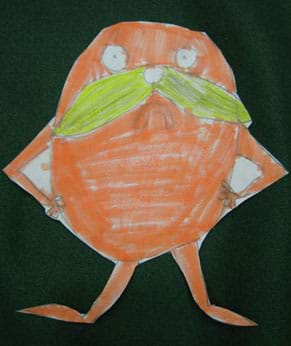
Summary
Students begin by reading Dr. Seuss' "The Lorax" as an example of how overdevelopment can cause long-lasting environmental destruction. Students discuss how to balance the needs of the environment with the needs of human industry. Student teams are asked to serve as natural resource engineers, city planning engineers and civil engineers with the task to replant the nearly destroyed forest and develop a sustainable community design that can co-exist with the re-established natural area.Engineering Connection
Engineers are involved in both the creation of the human-built environment — through the design of factories, housing, roads and bridges, as well as the protection of the natural environment — through resource management, city planning and sustainable building practices.
Learning Objectives
After this activity, students should be able to:
- Describe how engineers protect the environment through reducing pollution, protecting natural resources, and creative city planning.
- Explain that city planning involves balancing human and environmental needs.
- Calculate the time it takes for a forest to re-grow and understand why it takes so long.
Educational Standards
Each TeachEngineering lesson or activity is correlated to one or more K-12 science,
technology, engineering or math (STEM) educational standards.
All 100,000+ K-12 STEM standards covered in TeachEngineering are collected, maintained and packaged by the Achievement Standards Network (ASN),
a project of D2L (www.achievementstandards.org).
In the ASN, standards are hierarchically structured: first by source; e.g., by state; within source by type; e.g., science or mathematics;
within type by subtype, then by grade, etc.
Each TeachEngineering lesson or activity is correlated to one or more K-12 science, technology, engineering or math (STEM) educational standards.
All 100,000+ K-12 STEM standards covered in TeachEngineering are collected, maintained and packaged by the Achievement Standards Network (ASN), a project of D2L (www.achievementstandards.org).
In the ASN, standards are hierarchically structured: first by source; e.g., by state; within source by type; e.g., science or mathematics; within type by subtype, then by grade, etc.
NGSS: Next Generation Science Standards - Science
| NGSS Performance Expectation | ||
|---|---|---|
|
3-5-ETS1-1. Define a simple design problem reflecting a need or a want that includes specified criteria for success and constraints on materials, time, or cost. (Grades 3 - 5) Do you agree with this alignment? |
||
| Click to view other curriculum aligned to this Performance Expectation | ||
| This activity focuses on the following Three Dimensional Learning aspects of NGSS: | ||
| Science & Engineering Practices | Disciplinary Core Ideas | Crosscutting Concepts |
| Define a simple design problem that can be solved through the development of an object, tool, process, or system and includes several criteria for success and constraints on materials, time, or cost. Alignment agreement: | Possible solutions to a problem are limited by available materials and resources (constraints). The success of a designed solution is determined by considering the desired features of a solution (criteria). Different proposals for solutions can be compared on the basis of how well each one meets the specified criteria for success or how well each takes the constraints into account. Alignment agreement: | People's needs and wants change over time, as do their demands for new and improved technologies. Alignment agreement: |
| NGSS Performance Expectation | ||
|---|---|---|
|
5-ESS3-1. Obtain and combine information about ways individual communities use science ideas to protect the Earth's resources and environment. (Grade 5) Do you agree with this alignment? |
||
| Click to view other curriculum aligned to this Performance Expectation | ||
| This activity focuses on the following Three Dimensional Learning aspects of NGSS: | ||
| Science & Engineering Practices | Disciplinary Core Ideas | Crosscutting Concepts |
| Obtain and combine information from books and/or other reliable media to explain phenomena or solutions to a design problem. Alignment agreement: | Human activities in agriculture, industry, and everyday life have had major effects on the land, vegetation, streams, ocean, air, and even outer space. But individuals and communities are doing things to help protect Earth's resources and environments. Alignment agreement: | A system can be described in terms of its components and their interactions. Alignment agreement: Science findings are limited to questions that can be answered with empirical evidence.Alignment agreement: |
Common Core State Standards - Math
-
Reason abstractly and quantitatively.
(Grades
K -
12)
More Details
Do you agree with this alignment?
-
Use the four operations with whole numbers to solve problems.
(Grade
4)
More Details
Do you agree with this alignment?
-
Represent and interpret data.
(Grade
4)
More Details
Do you agree with this alignment?
International Technology and Engineering Educators Association - Technology
-
Waste must be appropriately recycled or disposed of to prevent unnecessary harm to the environment.
(Grades
3 -
5)
More Details
Do you agree with this alignment?
-
Determine factors that influence changes in a society's technological systems or infrastructure.
(Grades
3 -
5)
More Details
Do you agree with this alignment?
-
Develop innovative products and systems that solve problems and extend capabilities based on individual or collective needs and wants.
(Grades
6 -
8)
More Details
Do you agree with this alignment?
State Standards
Colorado - Math
-
Use the four operations with whole numbers to solve problems.
(Grade
4)
More Details
Do you agree with this alignment?
-
Represent and interpret data.
(Grade
5)
More Details
Do you agree with this alignment?
Colorado - Science
-
Create and evaluate models of the flow of nonliving components or resources through an ecosystem
(Grade
4)
More Details
Do you agree with this alignment?
-
Make a plan to positively impact a local ecosystem
(Grade
4)
More Details
Do you agree with this alignment?
Materials List
Each group needs:
- white copy paper, for drawing and calculating
- crayons, markers and/or colored pencils
- (optional) Re-Building the Forest Worksheet (A) or (B), one per student
For the entire class to share:
- The Lorax by Dr. Seuss (book)
- (optional,) The Lorax (video; available at most public libraries; runs 25 minutes; play either in lieu of reading the book aloud to the class, or while students are doing the drawing portion of the activity)
- large piece of felt (6 x 4 feet [1.8 x 1.2 m]; if possible, sew together one piece of blue and one piece of green to create a blank background scene)
- Velcro, the self-adhesive hook side, to stick drawings to the felt board (2-3 cm per student)
- (optional) additional Dr. Seuss books, as inspiration for drawings
Worksheets and Attachments
Visit [www.teachengineering.org/activities/view/cub_lorax_activity1] to print or download.Introduction/Motivation
You may know that engineers are responsible for much of the "built environment," including roads, bridges, buildings, skyscrapers, cars, airplanes and so forth, but did you know that engineers also help keep the natural environment safe and healthy? The responsibilities of many types of engineers ensure both public and environmental health. Their jobs are to balance human and environmental needs.
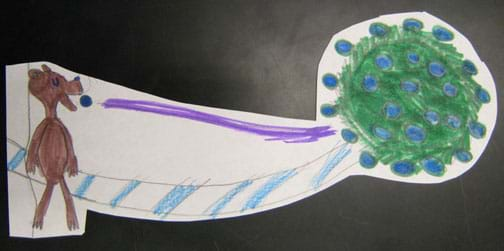
Would you want to live in a world without trees, fresh air, birds or barbaloots? What about a world without clean drinking water, warm houses, cars and roller coasters? Engineers have a big responsibility in how they use technology. Today, we are going to begin a project to plan a new town. To start, we are going to read The Lorax, a story by Dr. Seuss. This story shows us what can happen when the needs of the environment are not taken into consideration.
Procedure
City planning is the activity of determining the future physical arrangement and condition of a community. This involves examining the present condition, forecasting future requirements, creating a plan to fulfill these requirements, and securing proposals (construction, legal, financial) to implement the plan.
Dr. Seuss' book, The Lorax, has become a popular metaphor when speaking of the impact of human industry on its environment. Building on this story, students learn about city planning and how a variety of types of engineers work together to design and build a new city. Students learn that the fourth law of ecology, "there is no such thing as a free lunch," extends beyond the natural world and into the engineered world. Use this activity as a wrap up of an introduction to engineering and/or an Earth Day activity.
The Four Laws of Ecology by physicist and ecologist Barry Commoner:
- Everything is connected to everything else
- Everything must go somewhere
- Nature knows best
- There is no such thing as a free lunch.
Note about the worksheets: In Part 2, when students are asked to calculate how long it would take to re-build the forest, you have a few options. It is best if student teams are free to brainstorm an approach to solving the problem by themselves, by trial and error, using blank paper. But, if your teams could use some assistance, provide them with Re-Building the Forest Worksheet (A)— a blank table with column headers that serve as clues for how to think the problem through. For younger students, or those who even need more assistance, provide them with Re-Building the Forest Worksheet (B)— a blank table with specific years already in the first column, guiding them through year 42 by which time the forest would have 31 trees.
Before the Activity
- Gather materials.
- (optional; see worksheet note, above) Make copies of the Re-Building the Forest Worksheet, version A or B, one per student.
With the Students: Part 1: What's the Story?
- Read aloud to the class (or show the video of) Dr. Seuss' The Lorax.
- Use the following questions to lead a class discussion:
- Who is the Lorax? Who does he represent in the real world? (Answer: The Lorax is one of the main characters in the book and he "speaks for the trees." The Lorax represents environmentalists.)
- Who is the Once-ler? Who does he represent in the real world? (Answer: The Once-ler is another one of the main characters and he develops an industry selling thneeds. The Once-ler represents industries and factories that are not environmentally friendly.)
- Why is the Once-ler called the Once-ler? (Answer: The Once-ler only uses things once.)What is a thneed? Would you want one? Why or why not? (Answer: Students may come up with all of the ways you can use thneeds, as mentioned in the book. Talk about how some products are very useful and we need them, but not without some limitations about how many should be made, etc.)
- What happens after the Once-ler sets up his thneed factory? (Answer: The area is slowly destroyed by pollution. All of the animals leave and the once-beautiful truffula forest is left in ruins.)
- Where do all the animals go? Why do they leave? (Answer: The animals go off to different places in search of a healthier and safer environment. The pollution from the thneed factory forces them to leave.)
- What happens when the last truffula tree is chopped down? (Answer: The thneed factory closes down and the Once-ler's family leaves. The Once-ler finally sees what he has done to the natural area.)
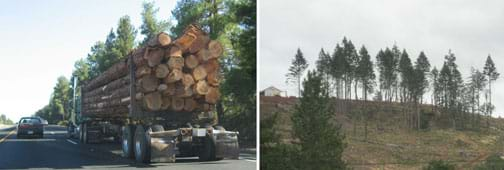
- Ask students to imagine that they are the child in the story and have just been given the last truffula seed and a big job to help plant replant the truffula forest.
- How long does it take for a healthy forest to grow back? Discuss students' ideas. Ask them to think of ways to prevent the forest from becoming depleted in the first place.
- Remind students that engineers are involved in city planning, from designing the buildings and roads, as well as how many and where to place them so as to reduce harmful environmental impacts. Ask students if they think they could design a town in which truffula trees and once-lers and loraxes and they (!) could all live together.
With the Students: Part 2: Re-Building the Truffula Forest (Math Calculation)
- Explain to students that it takes a long time to replant and re-grow a destroyed forest, which is why it is important to help protect our natural resources.
- With the students, discuss the last part of The Lorax story — when the Once-ler gives the boy the last truffula seed. (Re-read this section aloud.)
- Ask students to suggest how they might go about replanting the truffula forest. How long would it take? (Write students' guesses on the board.) Explain that today they will calculate how long it takes a forest to re-grow.
- Give students the following information and ask them to brainstorm in small groups how to calculate the length of time to re-grow a forest of at least 100 adult trees. As adapted from a section in The Lorax video, a single seed takes:
- 1 year to germinate into a sprout
- 10 years to grow into a sapling tree
- 10 more years to grow into an adult tree and produce new seeds
- Each tree can produce 10 seeds a year once it reaches maturity
- Have teams figure out on their own how to calculate the length of time. Have students choose one method from their group's brainstorming ideas and follow this approach to calculate the number of years. Ask each team to report to the class on the number of years it takes, based on their calculations. (Optional; provide a worksheet, version A or B, to assist students, as necessary; see note on worksheets, above.)
- As a class, talk about the different methods and how different groups may have calculated their times. Together, go through an example method (see Figure 1) (or use a worksheet) to ensure all students understand the calculation.
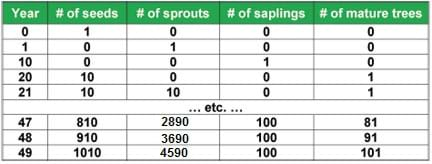
- Discuss with the class the length of time it takes to grow 100 adult trees. If you set the number of trees in a "healthy" forest to be 100 adult trees, it takes 49 years for the forest to grow back. Ask students if they noticed any patterns in the numbers during their calculations.
With the Students: Part 3: Design Planning
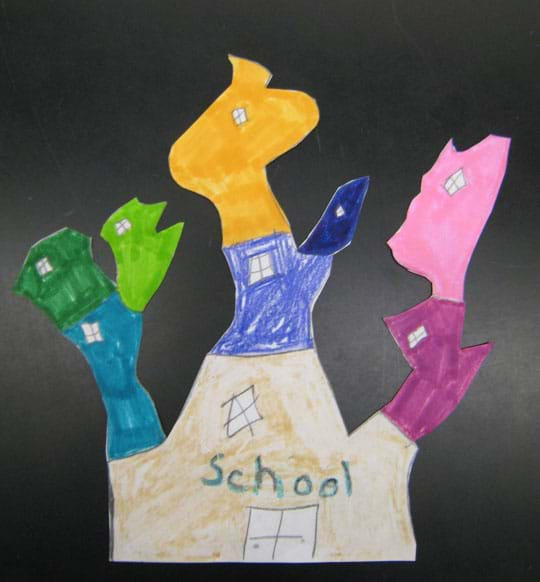
- Divide the class into groups that represent five different engineering teams involved in city planning. Assign one group to be the commercial team (businesses, shops, hotels, etc.), one group to be the industry team (thneed factories, etc.) one group to be the residential/neighborhoods team (schools, homes, apartments, etc.), one group to be the utilities team (light and power, water, waste) and the last group to be the parks and recreation team.
- Have each team come up with a goal for their part of the city planning. For example, the parks and recreation team might want to keep the environment safe and clean to allow for a healthy population of trees and animals, while providing ways for visitors to enjoy the parks. The utility team could focus on renewable energy or clean drinking water. The residential team could focus on having bike paths and sidewalks so that the people can walk safely around town. The industry team might focus on reducing emissions while also obtaining resources such as water for factory production. The commercial team might plan on being centrally located so people can walk to their stores.
- After each team comes up with their goal(s), write them on the board and ask students how they might get all of the goals to work together. Explain that sometimes teams of engineers must work together and compromise to reach their goals. Everyone might have to give and take a bit.
- As a class, come up with a sketch for a final city plan and zone areas for residential, commercial, industrial, municipal and recreational land use. How will the land be divided up? Draw the plan on the board or mark it up on the felt layout.
With the Students: Part 4: Draw the Town
- Have each team decide a number of things within their focus area that they want to create for the town. For example, the commercial team might draw a movie theater or an arcade. Each team member should draw at least one item that correlates to their specific area. (Additional examples: hospital, drinking water treatment facility, wastewater treatment facility, power plant, recycling center, garbage dump, roads, sidewalks and bike paths.)
- Direct the students to draw in Dr. Seuss style. (Have a few Dr. Seuss books on hand as examples, or play The Lorax video, which includes songs, while students work on their drawings.)
- In addition to the team drawings, have each student draw their own house or apartment to include in the new town.
- Once all drawings are ready, it is time to "build" the town. Ask students to come up to the felt board, one team at a time, to place their buildings, roads, etc., in the appropriate zones. Cut the self-adhesive hook Velcro into small pieces and adhere it to the drawings to make it easy to move items around during discussion and negotiation.
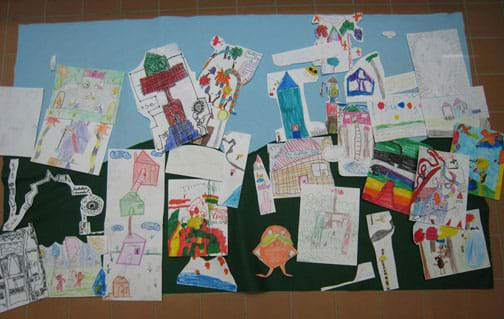
- After all the drawings are on the board, ask students if they want to make any changes. One way to do this is to make an inventory of the buildings and features of the town and see if anyone thinks of something important that may have been missed in the first brainstorming session. Now is the time to incorporate everyone's suggestions for improvement. This is a great time to talk about just how involved planning can be, and how many different groups and goals must be incorporated to be successful.
- Conduct the re-engineering activity in the Assessment section, making comparisons to the engineering design loop. Explain to students that when engineers design, they work in groups and follow the steps of the engineering design process: 1) understand the problem or need, 2) come up with creative ideas, 3) select the most promising idea, 4) communicate and make a plan to describe the idea, 5) create or build a prototype or model of the design, and 6) evaluate what you have made and make improvements (the cycle continues).
Vocabulary/Definitions
city planning: City planning is an approach to make sure a new community is well planned with appropriate zoning, and environmental and public health protections.
emissions: Emissions are waste substances released into the air or water.
environmental engineering: Engineering to improve the environment. Environmental engineers are involved in many fields, including environmental cleanup, natural resource management, water quality, waste disposal and air pollution prevention and clean-up.
environmentalist: A person who advocates or works to protect the air, water, animals, plants and other natural resources from destruction and/or pollution.
natural resource management: The planning and use of natural resources (land, water, soil, plants and animals) with special attention to long-term quality of life for people and the environment.
sustainability: Sustainability is meeting the needs of the present without compromising the ability of future generations to meet their own needs. (Source: US Environmental Protection Agency) Engineering sustainability is considering the needs of the future in the designs of today.
trade-offs: An exchange of one thing in return for another, especially giving up of one benefit or advantage for another regarded as more desirable.
Assessment
Pre-Activity Assessment
Open Discussion: Introduce the topic and gauge students' knowledge base by asking them the following questions:
- Do you think factories affect the environment? If yes, is it in a good way or a bad way?
- Could we get rid of factories all together? Why or why not?
Drawing: Ask students to draw pictures of factories. Have them label possible sources of pollution from the factory. Share some of the pictures with the class.
Activity Embedded Assessment
Drawings: Ask students to share their drawing with another person on their team or in another group. Ask them to describe the environmentally-friendly features of their drawings and how they fit in the new town plan.
Post-Activity Assessment
Engineering Trade-Offs: Engineers often must determine the best possible solution to a problem while balancing competing factors or trade-offs. Engage students in a discussion about any trade-offs they had to make while planning their town. For example, did they move any buildings to create more space for parks? Did they remove some stores to make space for homes? Did they relocate some buildings or services? Did they consider the economy of the town (factories, businesses) when they were considering environmental impact?
Re-Engineering: After students have created their town on the felt board, ask them if they see any problems with the town. Maybe some of the planning did not work out as they had hoped. Are they happy with the set-up of the town? Guide them to discover solutions to help reach the goals of the project to protect the environment and build a sustainable community. If their engineering team could change something, what would they change?
Troubleshooting Tips
Students tend to draw BIG pictures, so limit the size of paper provided, and make sure they know that all their drawings must collectively fit onto the felt board.
Activity Extensions
Bring to class a map of a local small town or community. Have students compare its layout to the one they created. How is it similar? How is it different? Do they notice any placement of buildings or parks that give them ideas to incorporate into their town design?
Activity Scaling
- For lower grades, use the attached Re-Building the Forest Worksheet (B) to guide students through the Step 2 calculations, instead of having them come up with a method themselves.
- For upper grades, have them calculate the number of years it takes to re-grow the forest on their own before they are led through the answer. If they need some help, provide them with the attached Re-Building the Forest Worksheet (A).
- For very advanced math students, have them write out a number sentence or formula to describe the patterns in their data describing the growth of the forest.
Subscribe
Get the inside scoop on all things TeachEngineering such as new site features, curriculum updates, video releases, and more by signing up for our newsletter!References
Dictionary.com. Lexico Publishing Group, LLC. Accessed October 11, 2008. (Source of some vocabulary definitions, with some modifications) http://www.dictionary.com
The Lorax. 1937-2008. Dr. Seuss Enterprises, L.P., Random House, Inc. Accessed October 10, 2008. http://www.seussville.com/lorax/
The Lorax Summary. ThinkQuest. Accessed October 10, 2008. http://library.thinkquest.org/CR0210462/loraxsum.html
Morash, Emily. The Four Laws of Ecology by physicist and ecologist Barry Commoner. Global Geography 12 (GGS12), Global Connections, Geography for the 21st Century (textbook). Accessed October 11, 2008. http://emilymorash07.tripod.com/id12.html
Seuss, Dr. The Lorax. Random House: New York, NY (ISBN: 978-0-394-82337-9) 1971
Seussville. 1937-2008. Dr. Seuss Enterprises, L.P., Random House, Inc. Accessed October 10, 2008. http://www.seussville.com
Sustainability. Last updated October 9, 2008. U.S. Environmental Protection Agency. Accessed October 10, 2008. http://www.epa.gov/Sustainability/
Copyright
© 2008 by Regents of the University of Colorado.Contributors
Kate Beggs; Malinda Schaefer Zarske; Jacob Crosby; Denise W. CarlsonSupporting Program
Integrated Teaching and Learning Program, College of Engineering, University of Colorado BoulderAcknowledgements
The contents of this digital library curriculum were developed under a grant from the Fund for the Improvement of Postsecondary Education (FIPSE), U.S. Department of Education and National Science Foundation GK-12 grant no. 0338326. However, these contents do not necessarily represent the policies of the Department of Education or National Science Foundation, and you should not assume endorsement by the federal government.
Last modified: December 23, 2021






User Comments & Tips